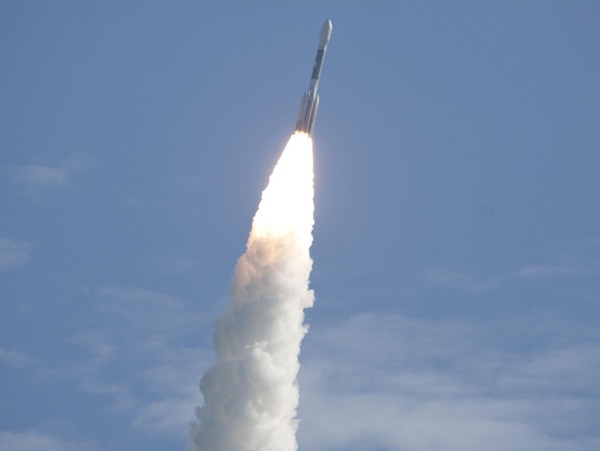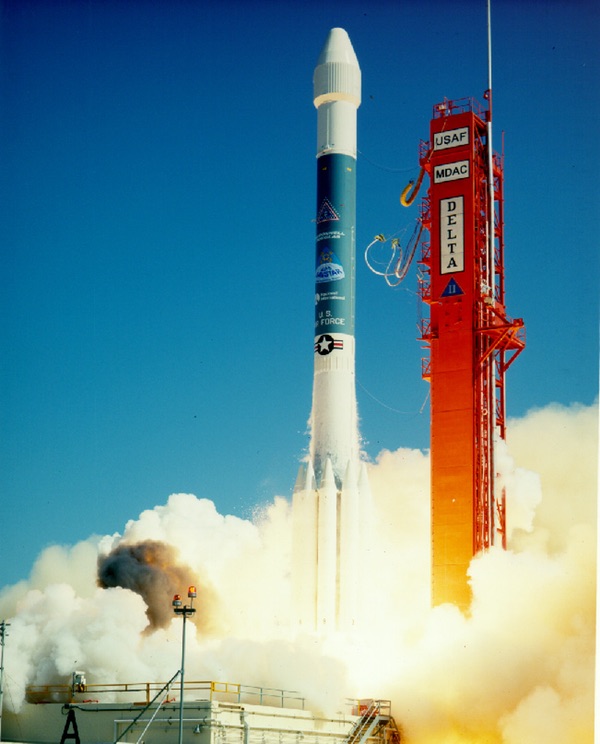Delta II: End of an eraby James Michael Knauf
|
| Amid talk of super-heavy launch vehicles it is easy to forget the outsized presence of this comparatively diminutive rocket in the pantheon of space launch systems. |
Delta II’s payload that Valentine’s Day, launched as the Navstar II-1 mission, was the first Global Positioning System (GPS) Block II satellite, originally planned for launch on the shuttle. Space Vehicle Number (SVN) 14 was the first satellite of what would become the first truly operational space-based navigation constellation.
As the countdown proceeded on launch day, the team’s engineers and technicians ran final checks on the spacecraft that was perched atop the Delta II from a small control center in the Navstar Processing Facility (NPF), 2.9 kilometers (1.8 miles) away from the launch pad. The team was eager to launch. A launch attempt two days earlier had been scrubbed on an otherwise beautiful, clear day due to high-altitude winds.
This inaugural launch culminated three years of integrated launch preparations by the combined team of Air Force 6555th Aerospace Test Group (ASTG), spacecraft contractor Rockwell International, and launch vehicle contractor McDonnell-Douglas personnel. In the aftermath of Challenger, revised GPS integration activities had included assisting the Air Force and contractor program offices in Los Angeles with the engineering and operations transition from flying GPS on the Space Shuttle as originally intended, to flying on the Delta II expendable rockets. Activities included modifying and activating the NPF in an old Minuteman Assembly Building. Here, the team prepared GPS satellites and Payload Assist Module (PAM-D) third stages for launch.
As the team monitored the spacecraft from the NPF’s control center during countdown, three more GPS satellites awaited launch in a room next door, refugees from planned launch on the shuttle. Most of the team had witnessed the Challenger accident on that clear, colder day three years earlier.
More GPS satellites were in various stages of completion at the Rockwell factory in Seal Beach, California: almost an aircraft or automobile assembly line, but for satellites. The Air Force planned to build 17 more of them.
Block II satellites would comprise the first operational GPS Position, Navigation, and Timing (PNT) system, building on the ten Block I concept validation satellites the Air Force had successfully launched and deployed between 1978 and 1985 (one was lost in an unsuccessful launch in 1981.)
When Operation Desert Shield began a year and a half after this initial GPS Block II launch, the Air Force had not yet fully deployed the planned constellation of satellites. The Air Force would launch three more GPS satellites before Operation Desert Storm began in January 1991. The combination of remaining on-orbit Block I satellites and the partially deployed constellation of Block II satellites, along with rapidly built up GPS ground equipment, provided a significant contribution to Desert Shield/Desert Storm, the first space war.
| The Delta II poised for its first flight from Launch Complex 17 had evolved from the venerable Delta rocket, which had evolved from the Thor intermediate range ballistic missile, a weapon. |
GPS reached full operational capacity in 1995 and has since become ubiquitous, an essential element of the global information infrastructure. Today, besides its availability to United States and allied armed forces and approved government agencies, it is freely available to civilian users on a continuous, worldwide basis. Hundreds of applications affect every part of modern life. GPS technology is now in everything from cell phones and wristwatches to bulldozers, shipping containers, and ATMs.
The Delta II poised for its first flight from Launch Complex 17 had evolved from the venerable Delta rocket, which had evolved from the Thor intermediate range ballistic missile, a weapon. Delta had been a workhorse space launch vehicle before production was ended because of the decision to fly US payloads on the Space Shuttle. Challenger and a rapid succession of launch failures of every US expendable launch vehicle in 1986 and 1987—Titan, Delta, and Atlas—highlighted the need for an alternative to the shuttle for access to space.
Following Challenger and an earlier Titan failure five months before, a Titan 34D exploded over the launch pad at Vandenberg Air Force Base in April 1986, followed a month later by the failure of Delta 178 failed in May. The following March, lightning struck AC-67, an Atlas Centaur, resulting in loss of the vehicle and mission. The shuttle did not return to flight until September 1988, and by then, the transition of many of its payloads back to expendable launch vehicles had begun.
As part of the Air Force Medium Launch Vehicle (MLV) program, McDonnell Douglas restarted Delta production and evolved to a new vehicle configuration. The 6925 configuration included a first stage stretched by 3.65 meters (12 feet), a wider 2.9-meter (9.5-foot) diameter payload fairing, nine Castor IVA strap-ons solid rockets, and a PAM-D third stage. The firm also upgraded launch pads and other facilities at Cape Canaveral and Vandenberg Air Force Base to accommodate the modified rockets.
 A Delta II rocket launches NASA’s GRAIL mission to the Moon on September 10, 2011. (credit: NASA/Darrell McCall) |
Delta II ultimately lofted eight more Block II satellites and 40 GPS Block IIA, IIR, and IIR-M satellites, as well as an impressive string of scientific and commercial spacecraft. For NASA, this included highly publicized exploration missions and their spectacular discoveries, such as the Mars Pathfinder, Spirit, and Opportunity Mars missions; the MESSENGER mission to Mercury; the Dawn mission to the asteroids; and the Kepler observatory that has discovered thousands of extrasolar planets. Commercial launches include the Globalstar and Iridium satellite constellations.
Delta II evolved further in the decades after this inaugural launch, adding solid rocket motors, length, and lift capability, becoming a workhorse launch vehicle while maintaining an enviable success rate of over 99 percent. There has been just one failure in 154 flights to date, the GPS IIR-1 mission January 17, 1997.
Not bad for a so-called “heritage” rocket that predated the Evolved Expendable Launch Vehicle (EELV) program. Still six years in the future, EELV intended to replace Delta II, Atlas II/III, and Titan rockets. Delta II was one of EELV’s evolutionary “parents,” but would continue to fly and evolve in parallel.
All good things end or, perhaps, evolve. The Air Force decommissioned GPS SVN 14 after 11 years of service on April 14, 2000. The Air Force inactivated the 6555th ASTG and its Vandenberg counterpart in 1990, but the 45th and 30th Space Wings and their subordinate units continue the launch mission today.
| This final Delta II mission is a fitting bookend to a significant launch era that began with the first Delta II launching on a Valentine’s Day just short of three decades ago. |
Boeing acquired spacecraft contractor Rockwell International and Delta II manufacturer McDonnell Douglas. Delta II production and operations then became part of the United Launch Alliance, the Boeing-Lockheed Martin joint venture.
No longer needed after over half a century of service, the twin launch towers at Cape Canaveral’s Launch Complex 17 were toppled earlier this year, in July.
The first GPS Block III satellite arrived at Cape Canaveral earlier this month for its planned launch in December on a SpaceX Falcon 9.
Now, United Launch Alliance is completing preparations to launch a Delta II carrying the ICESat-2 spacecraft. This 155th Delta II will be a 7420 configuration with four GEM-40 strap-on solid rocket boosters and no third stage. It will carry the Ice, Cloud, and Land Elevation Satellite-2 spacecraft, ICESat-2, that will measure the elevation of ice sheets, glaciers, sea ice, the heights across Earth’s temperate and tropical regions, and the vegetation in forests worldwide.
Launching from Vandenberg Air Force Base, this final Delta II mission is a fitting bookend to a significant launch era that began with the first Delta II launching the first GPS Block II satellite from Cape Canaveral on a Valentine’s Day just short of three decades ago.
Note: we are temporarily moderating all comments subcommitted to deal with a surge in spam.
